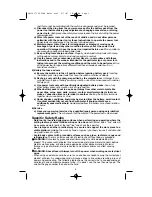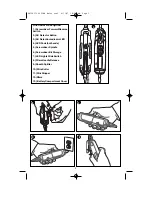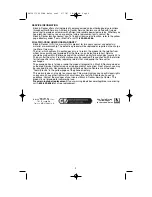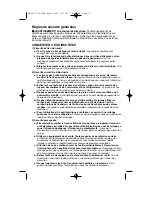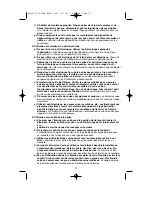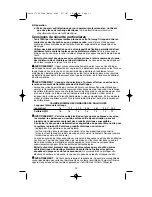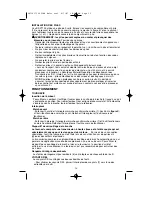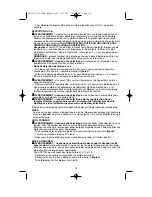
3
tool that cannot be controlled with the switch is dangerous and must be repaired.
c) Disconnect the plug from the power source and/or the battery pack from the
power tool before making any adjustments, changing accessories, or storing
power tools.
Such preventive safety measures reduce the risk of starting the power
tool accidentally.
d) Store idle power tools out of the reach of children and do not allow persons
unfamiliar with the power tool or these instructions to operate the power tool.
Power tools are dangerous in the hands of untrained users.
e) Maintain power tools. Check for misalignment or binding of moving parts,
breakage of parts and any other condition that may affect the power tools
operation. If damaged, have the power tool repaired before use.
Many accidents
are caused by poorly maintained power tools.
f) Keep cutting tools sharp and clean.
Properly maintained cutting tools with sharp
cutting edges are less likely to bind and are easier to control.
g) Use the power tool, accessories and tool bits etc., in accordance with these
instructions and in the manner intended for the particular type of power tool,
taking into account the working conditions and the work to be performed.
Use
of the power tool for operations different from those intended could result in a
hazardous situation.
5) Battery tool use and care
a) Ensure the switch is in the off position before inserting battery pack.
Inserting
the battery pack into power tools that have the switch on invites accidents.
b) Recharge only with the charger specified by the manufacturer.
A charger that is
suitable for one type of battery pack may create a risk of fire when used with another
battery pack.
c) Use power tools only with specifically designated battery packs.
Use of any
other battery packs may create a risk of injury and fire.
d) When battery pack is not in use, keep it away from other metal objects like
paper clips, coins, keys, nails, screws, or other small metal objects that can
make a connection from one terminal to another.
Shorting the battery terminals
together may cause burns or a fire.
e) Under abusive conditions, liquid may be ejected from the battery, avoid contact.
If contact accidentally occurs, flush with water. If liquid contacts eyes,
additionally seek medical help.
Liquid ejected from the battery may cause irritation
or burns.
6) Service
a) Have your power tool serviced by a qualified repair person using only identical
replacement parts.
This will ensure that the safety of the power tool is maintained.
Specific Safety Rules
• Hold tool by insulated gripping surfaces when performing an operation where the
cutting tool may contact hidden wiring or its own cord.
Contact with a "live" wire will
make exposed metal parts of the tool "live" and shock the operator.
• Use clamps or another practical way to secure and support the work piece to a
stable platform.
Holding the work by hand or against your body leaves it unstable and
may lead to loss of control.
•
Avoid body contact with grounded surfaces such as pipes, radiators, ranges and
refrigerators.
There is an increased risk of electric shock if your body is grounded.
WARNING:
Occasionally, pipes and electrical wiring may not be detected by this
product. The sensor will not detect live wires inside metal pipe or metal conduit, behind
metallic wall covering, or behind some plywood or other dense materials. Material
thickness, type of material, moisture content, and other variables can affect sensing
results.
WARNING: Shock Hazard. Always turn off the power when working near electrical
wires.
•
When using an extension cord, be sure to use one heavy enough to carry the current your
product will draw. An undersized cord will cause a drop in line voltage resulting in loss of
power and overheating. The following table shows the correct size to use depending on
cord length and nameplate ampere rating. If in doubt, use the next heavier gage. The
smaller the gage number, the heavier the cord.
90519175 SPT100 Multi tool 6/7/07 10:10 AM Page 3



